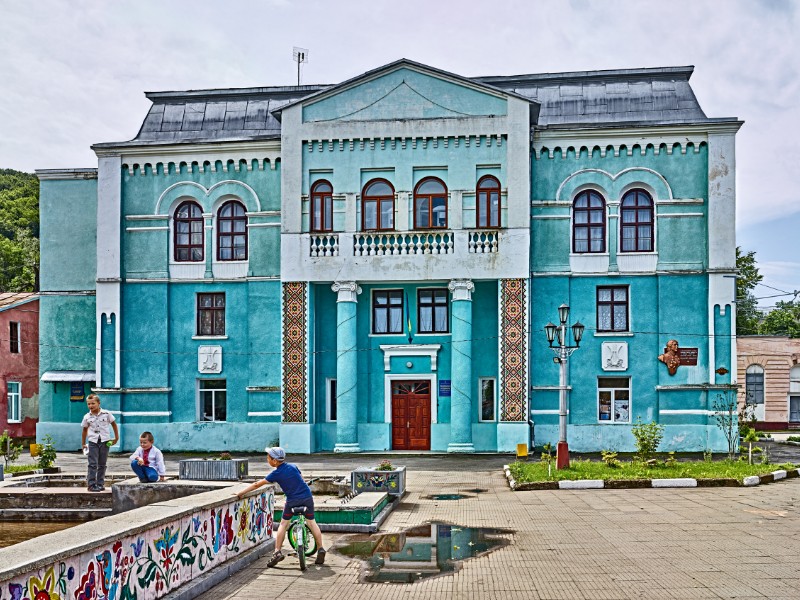Back in 1992, David Kaufman, an acclaimed photographer and an award-winning documentary filmmaker, was in Poland doing research for CBC television on Polish child survivors of the Holocaust.
His trip coincided with the discovery of a Jewish burial site near Warsaw. The tombstones of the former Jewish cemetery were lined up and standing vertically. “I was blown away by their beauty,” he said. “I had never seen Jewish monuments so rich and ornate in calligraphy and iconography.”
In 2007 he returned to Poland and over seven successive trips spanning nine years – he also visited Ukraine – Kaufman set out to photograph Jewish cemeteries, as well as prewar synagogues, and Jewish residential and communal buildings that had survived destruction by the Nazis.
An exhibition of these photographs, titled, The Posthumous Landscape: Jewish Historical Sites in Poland and Western Ukraine, is currently being shown at Congregation Darchei Noam.
Kaufman’s large scale, highly detailed photographs give the viewer a glimpse of Jewish life in the cities and towns, where a sizeable part of the local population was Jewish.
His images document synagogues in disrepair and over-grown cemeteries along with functioning synagogues that have been beautifully restored and stately turn-of-the-century buildings that were built and formerly inhabited by Jews.
Ukraine has many Jewish sites, particularly cemeteries, but efforts to preserve them are limited. “The state of burial sites range from well-cared for to abandoned due to underfunding,” Kaufman said.
He and other photographers document these Jewish sites to encourage preservation, however, he lamented that with the continual physical deterioration of these sites “the photographs will be all that remains.”
The images in this current exhibit encompass places in Warsaw and Lodz in Poland, and Lviv, Vyzhnytsia and the Chernivtsi area in Ukraine. Lviv had been part of Poland between the two world wars.
Warsaw, once home to 375,000 Jews, has almost no Jewish landmarks, because the city was a battle ground during the Second World War. However, Kaufman pointed out that Okopowa Street Cemetery with over 225,000 burial sites and innumerable monuments is a treasure trove of Warsaw’s Jewish “material history.”
In contrast to Warsaw, parts of Lodz once inhabited by Jews, have not changed for 80 years, Kaufman said. “A significant percentage of the buildings in Baluty, the poor district at the heart of the former ghetto, remain intact and substantially unaltered since the conflict.”

In Lodz he also photographed the palace and manufacturing compound of the Jewish textile magnate, Izrael Kalman Poznanski. He built factories and residences for his workers in the late 19th century. These buildings are intact and are now repurposed, as are so many of the area’s former Jewish sites.
Kaufman also noted that the Jewish cemetery in Lodz is one of the largest in the world.
One of the most striking photographs on display is of a group of children playing outside Vyzhnytsia’s cultural centre. This stately three-storey building was formerly the town’s largest synagogue.
Before the war Vyzhnytsia or Vizhnitz in Yiddish – it’s 75 kilometres west of Chernivtsi – was 90 per cent Jewish. Today there are no Jews there. The Vizhnitz dynasty, the second largest Hasidic sect in Israel, originated in this town.
In Lviv (known formerly as Lvov and Lemberg) one of Kaufman’s subjects is a building with well-preserved commercial inscriptions in Yiddish. He said such Yiddish advertising is referred to as “ghost signs.”
Originally from Montreal, Kaufman had has an impressive career as a documentary filmmaker. In addition to producing documentary segments for CBC’s The Journal in the mid-1980s, he later produced and directed more than 50 documentary and investigative reports on a variety of issues for CBC’s The Fifth Estate.
Kaufman became an independent filmmaker in 1999. Many of his films have Jewish themes.
Since 2010, his professional focus has been on photography. Over the years, he has had 16 solo photography shows.
Architectural photography has been an integral part of Kaufman’s body of work since 1984. His subject matter has included cityscapes and period buildings in Toronto, Montreal and New York.
However, he is also the official photographer for Toronto’s Ashkenaz Festival as well as KlezKanada, the annual week-long, summer Yiddish music and cultural festival in Quebec.
The Posthumous Landscape is on display at Congregation Darchei Noam (864 Sheppard Ave. W.) until April 16. Copies of all the prints in this exhibition are available for purchase. Kaufman can also lead guided tours of this exhibit for groups. He can be contacted at www.davidkaufmanphotography.com.
